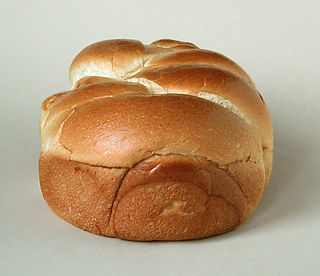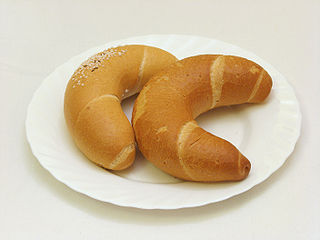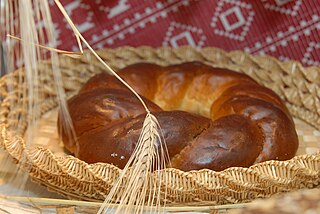
A doughnut or donut is a type of pastry made from leavened fried dough. It is popular in many countries and is prepared in various forms as a sweet snack that can be homemade or purchased in bakeries, supermarkets, food stalls, and franchised specialty vendors. Doughnut is the traditional spelling, while donut is the simplified version; the terms are used interchangeably.

Brioche is a pastry of French origin whose high egg and butter content gives it a rich and tender crumb. The chef Joël Robuchon described it as "light and slightly puffy, more or less fine, according to the proportion of butter and eggs". It has a dark, golden, and flaky crust, frequently accentuated by an egg wash applied after proofing.

Dough is a thick, malleable, sometimes elastic paste made from grains or from leguminous or chestnut crops. Dough is typically made by mixing flour with a small amount of water or other liquid and sometimes includes yeast or other leavening agents, as well as ingredients such as fats or flavorings.

Fruitcake or fruit cake is a cake made with candied or dried fruit, nuts, and spices, and optionally soaked in spirits. In the United Kingdom, certain rich versions may be iced and decorated.

The Striezelmarkt in Dresden is one of the first genuine Christmas markets in the world. Founded as a one-day market in 1434, it celebrated its 585th anniversary in 2019. Its 240 stands attract about 3 million visitors from all over the world. The annual market lasts throughout the Advent season until Christmas Eve.

Challah is a special bread of Ashkenazi Jewish origin, usually braided and typically eaten on ceremonial occasions such as Shabbat and major Jewish holidays. Ritually acceptable challah is made of dough from which a small portion has been set aside as an offering. Challah may also refer to the dough offering. The word is biblical in origin, meaning "loaf". Similar braided breads such as kalach and vánočka are found across Central and Eastern Europe.

Stollen is a fruit bread of nuts, spices, and dried or candied fruit, coated with powdered sugar or icing sugar and often containing marzipan. It is a traditional German Christmas bread. During the Christmas season the cake-like loaves are called Weihnachtsstollen or Christstollen.

Kifli, kiflice, kifle, or kipferl is a traditional yeast bread roll that is rolled and formed into a crescent before baking.

Potato bread is a form of bread in which potato flour or potato replaces a portion of the regular wheat flour. It is cooked in a variety of ways, including baking it on a hot griddle or pan, or in an oven. It may be leavened or unleavened, and may have a variety of other ingredients baked into it. The ratio of potato to wheat flour varies significantly from recipe to recipe, with some recipes having a majority of potato, and others having a majority of wheat flour. Some recipes call for mashed potatoes, with others calling for dehydrated potato flakes. It is available as a commercial product in many countries, with similar variations in ingredients, cooking methods, and other variables.

Kolach or kalach is a traditional bread found in Central and Eastern European cuisines, commonly served during various special occasions – particularly wedding celebrations, Christmas, Easter, and Dożynki. The name originates from the Old Slavonic word kolo (коло) meaning "circle" or "wheel". Korovai is sometimes categorised as a type of kolach.

Paska is a Ukrainian Easter bread. It is particularly spread in Central and Eastern Europe, and countries with cultural connections to the ancient Byzantine Empire, Eastern Orthodoxy or Eastern Catholicism. Easter breads are a traditional element in the Easter holidays of Armenia, Belarus, Bulgaria, Croatia, Georgia, Moldova, Romania, Russia, Poland, Slovakia and Ukraine. It is also a common tradition amongst the Assyrian-Chaldean-Syriac diaspora. It is also eaten in countries with large immigrant populations from Central and Eastern Europe such as the United States, Canada and the United Kingdom.

Cozonac or Kozunak is a sweet yeast dough that can be used to make different traditional holiday breads and cakes. Often mixed with raisins, it can be baked as a loaf or rolled out with fillings like poppy seed or walnuts. It is common throughout Southeastern Europe in countries such as Romania, Moldova, Bulgaria, Serbia, North Macedonia and Greece. Rich in eggs, milk and butter, it is usually prepared for Easter in Romania, Serbia, Bulgaria, and in Romania and Moldova it is also traditional for Good Friday. The name comes from the Bulgarian word for hair-коса/kosa, or Greek: κοσωνάκι, romanized: kosōnáki, a diminutive form of κοσώνα, kosṓna.

Kürtőskalács is a spit cake specific to Hungarians from Transylvania, more specifically the Székelys. Originally popular in the Székely Land, it became popular in both Hungary and Romania. The first written record dates back to 1679 and was found in the village of Úzdiszentpéter, while the first recipe appears in a manuscript cookbook dated in 1781. Earlier a festive treat, now it is part of everyday consumption. A similar pastry to Kürtőskalács is Baumstriezel, originating in the Transylvanian Saxon communities.
Saxon cuisine encompasses regional cooking traditions of Saxony. In general the cuisine is very hearty and features many peculiarities of Mid-Germany such as a great variety of sauces which accompany the main dish and the fashion to serve Klöße/Knödel as a side dish instead of potatoes, pasta or rice. Also much freshwater fish is used in Saxon cuisine, particularly carp and trout as is the case throughout Eastern Europe.

Eierschecke is a confectionery speciality from Saxony and Thuringia. It is a layer cake with a base layer of cake, a middle layer of quark-based cheesecake and a top layer of vanilla custard. Parts of it are covered with a glaze made of cream, whole egg, sugar and flour for thickening. The term originates from a piece of 14th century menswear called Schecke which consisted of a medium-length tunic with a very tight waistline and was worn with a Dusing, a hip belt. The cake was named after the appearance of this "tripartite garment".

Swabian cuisine is native to Swabia, a region in southwestern Germany comprising great parts of Württemberg and the Bavarian part of Swabia. Swabian cuisine has a reputation for being rustic, but rich and hearty. Fresh egg pastas, soups, and sausages are among Swabia's best-known types of dishes, and Swabian cuisine tends to require broths or sauces; dishes are rarely "dry".

A spit cake is a European-styled cake made with layers of dough or batter deposited, one at a time, onto a tapered cylindrical rotating spit. The dough is baked by an open fire or a special oven, rotisserie-style. Generally, spit cakes are associated with celebrations such as weddings and Christmas. The spit can be dipped in a thin dough, or the dough can be poured or rolled on the spit.

















